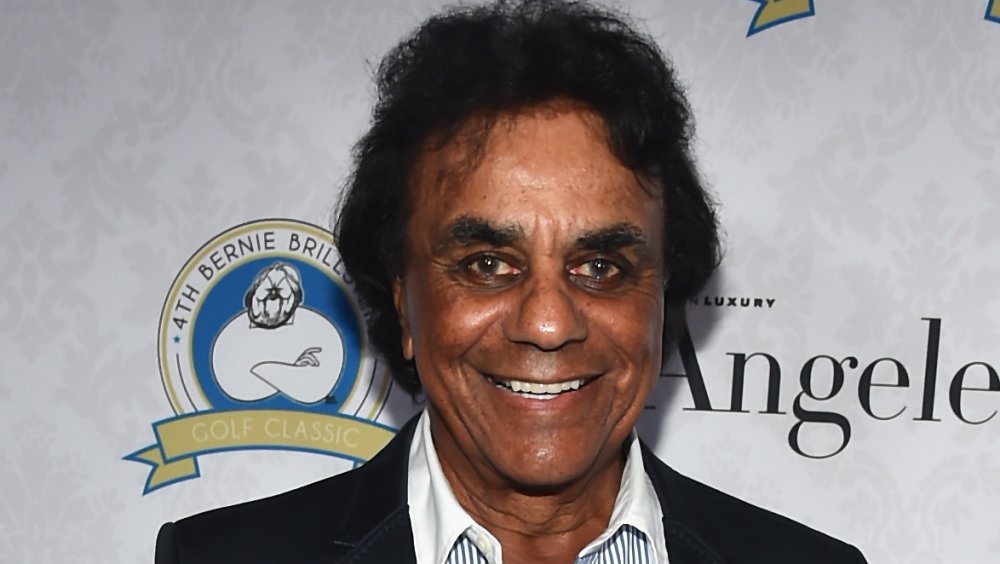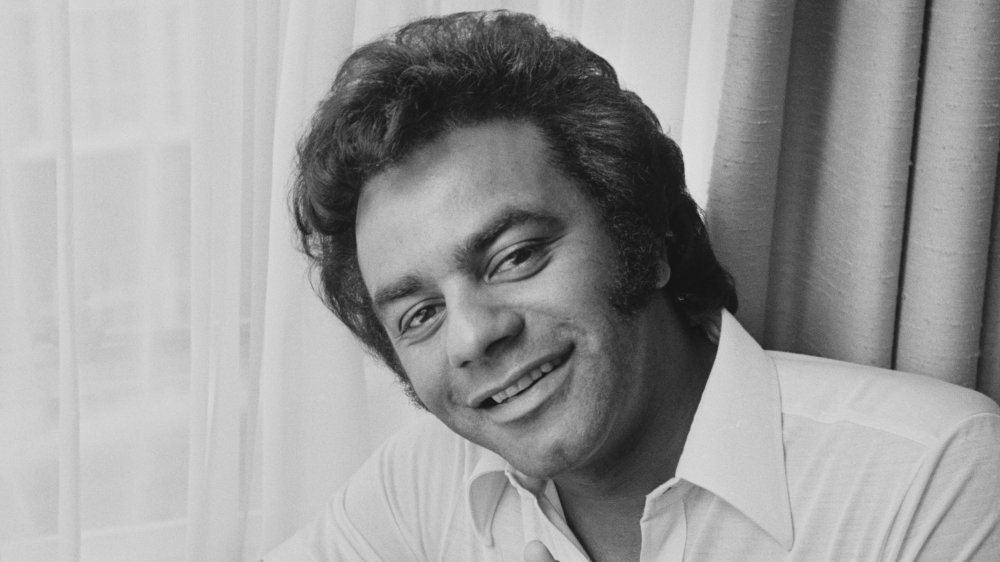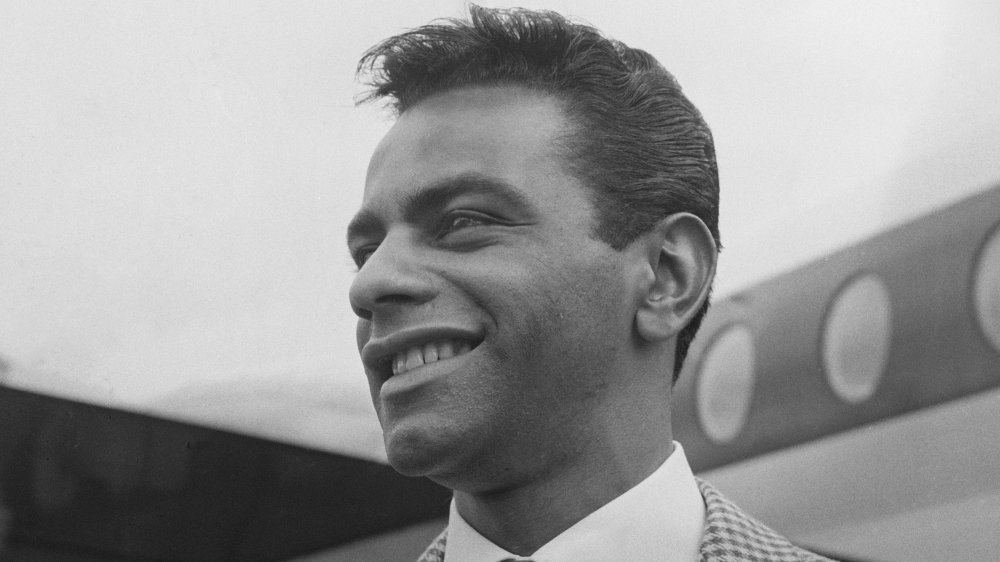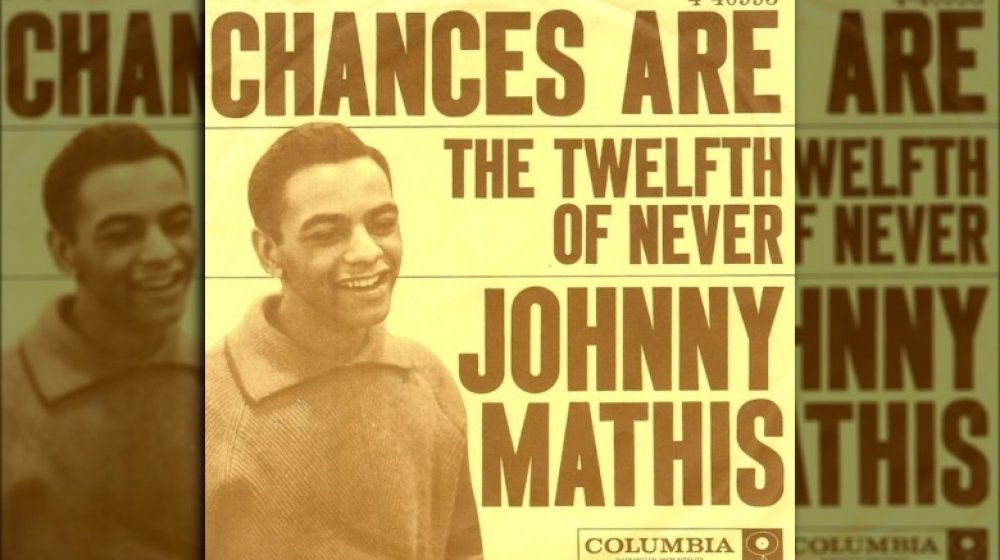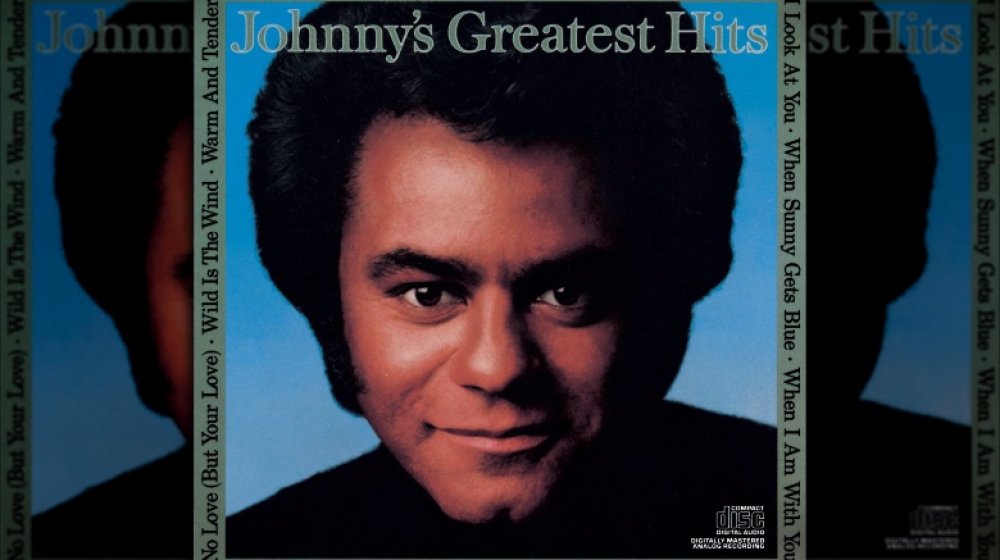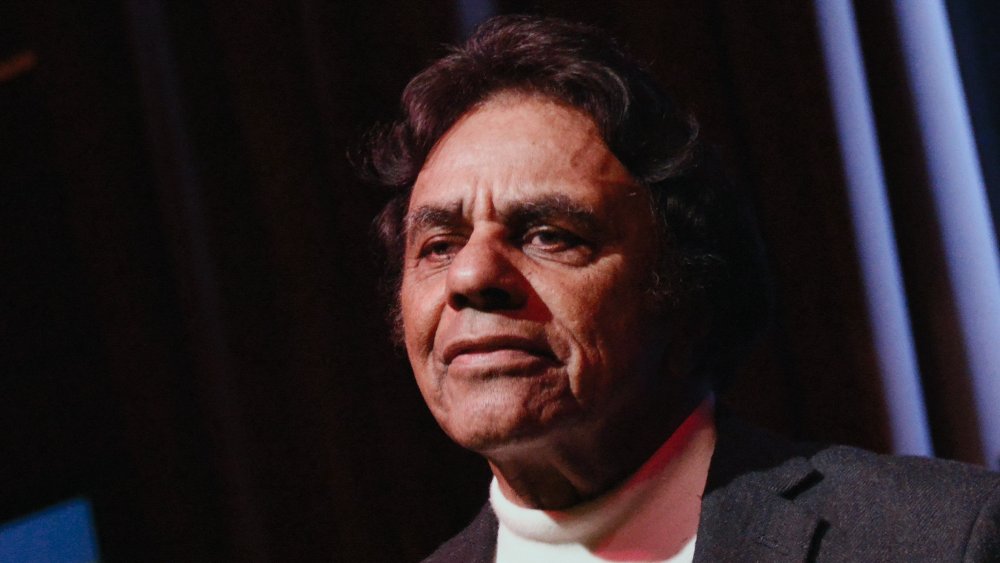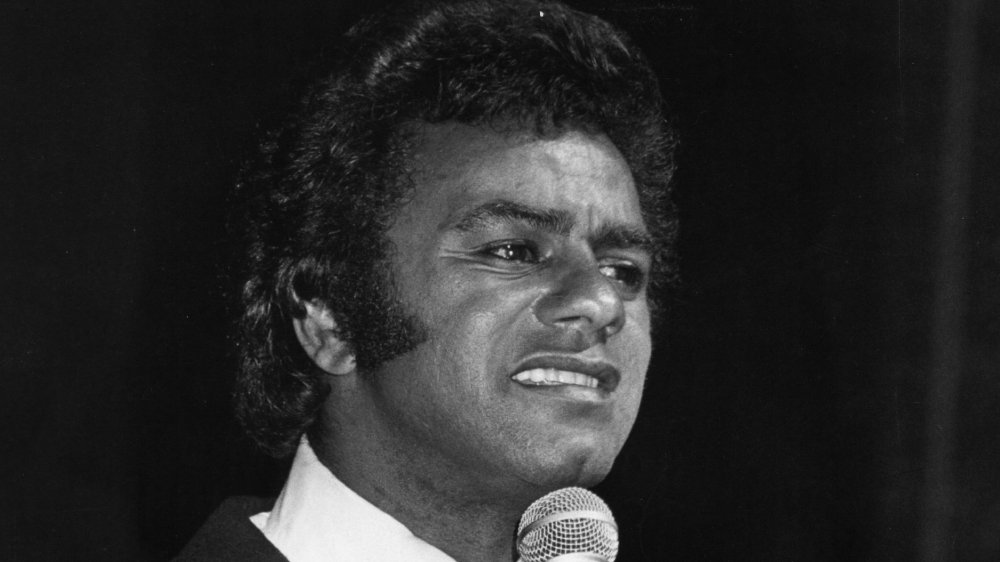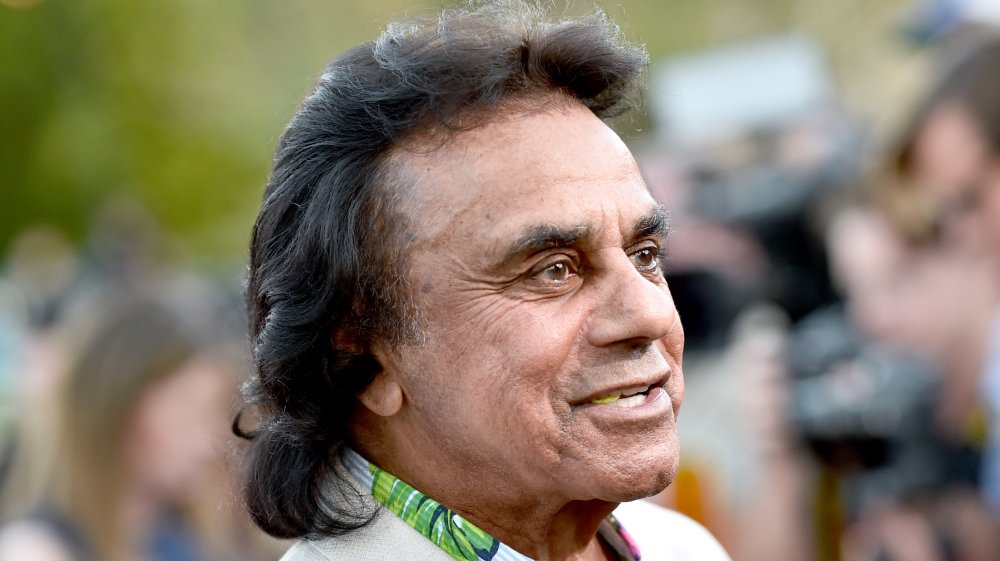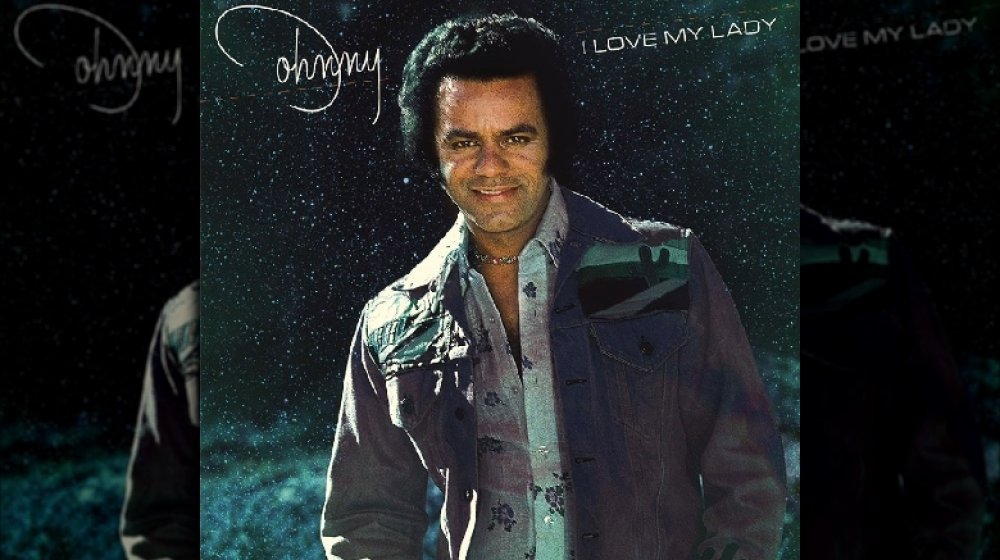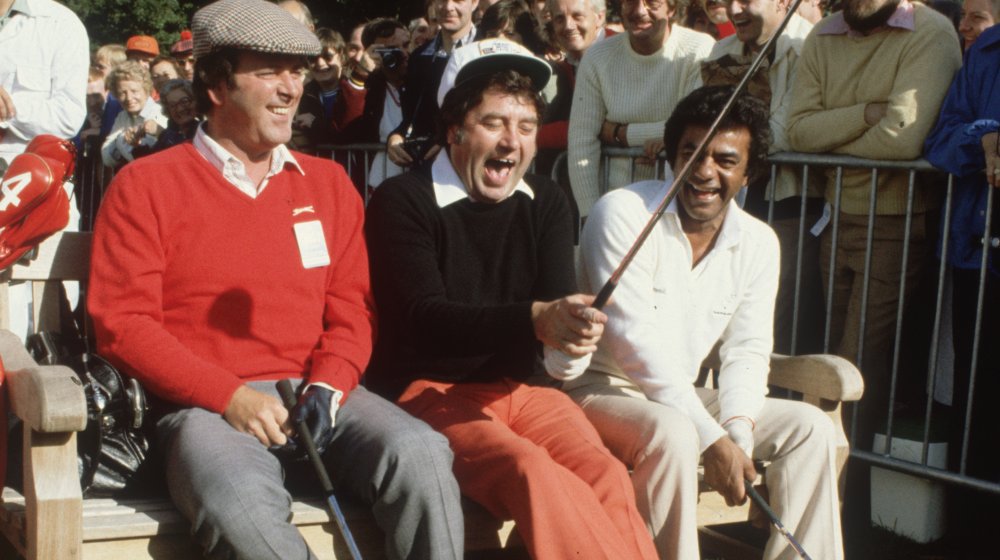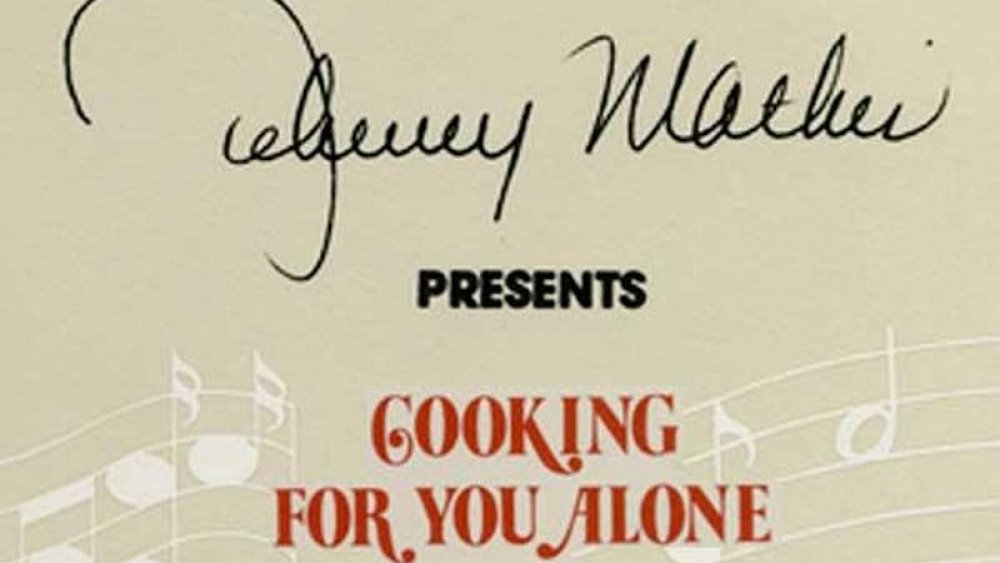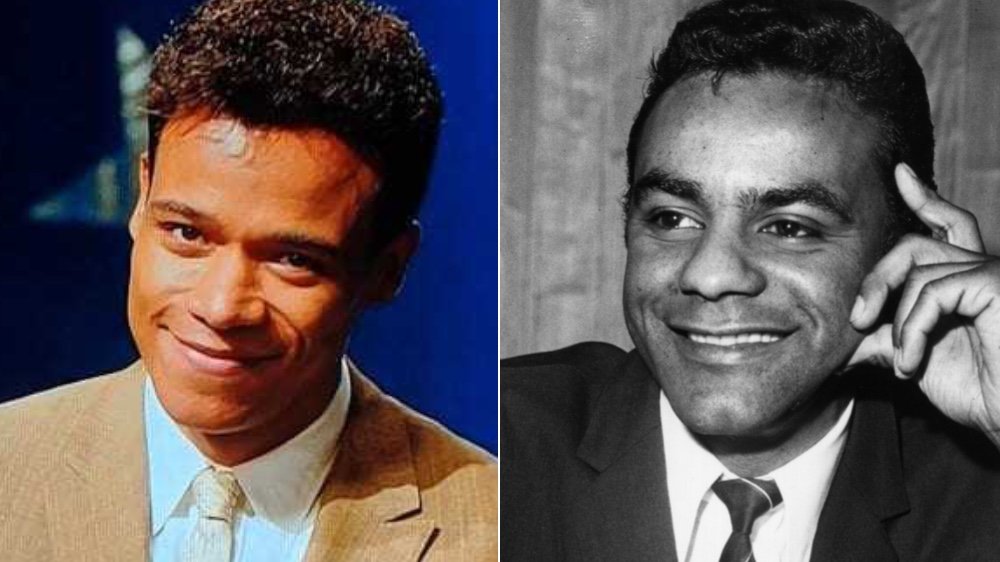The Untold Truth Of Johnny Mathis
While rock 'n' roll, with its hip-swiveling singers and impassioned, euphemistic lyrics, ran rampant and ensnared millions of young Americans, Johnny Mathis held it down for the crowd who preferred something a little sweeter, softer, and mellower. An old-school crooner more akin to Frank Sinatra than Jerry Lee Lewis, Mathis was elegant, consistent, and, most of all, romantic. His bevy of carefully sung, impeccably enunciated hits provided the soundtrack for mid-century love, including "Chances Are," "The Twelfth of Never," "Misty," "It's Not For Me to Say," and "Wonderful! Wonderful!" Ask your mom or grandma about Johnny Mathis — heterosexual women of the era positively adored the honey-throated singer known far and wide as simply "Johnny."
Mathis sold millions of records and kept turning out soft pop singles well into the 20th century, and even in his eighties, he remained a concert draw. Here's a look into the long and fascinating life of Johnny Mathis, the undisputed king of soft rock.
Johnny Mathis was a wonderful, wonderful athlete
Not merely an incredible singer, Johnny Mathis was also incredible at sports. According to the Academy of Achievement, Mathis was a standout athlete as a teenager, a member of the basketball team at San Francisco's George Washington High School, as well as the track and field team. According to The Daily Gazette, Mathis was so skilled at the high jump that it earned him an athletic scholarship to San Francisco State College. Per the San Francisco Chronicle, he could regularly and easily clear 6'5", even though he was a relatively short 5'7". Mathis' crosstown rival was 6'9" University of San Francisco high jumper Bill Russell, who went on to win 11 NBA championships with the Boston Celtics. Nevertheless, Mathis once beat Russell, clearing 6'5.5" at a tournament in Nevada.
All that earned Mathis an invitation to attend the 1956 Olympic trials. While they were being held not too far from home in Berkeley, California, Mathis couldn't go — the same week he got the call from the Olympics, he was summoned to New York for his first recording session. Nevertheless, Mathis's impact on Bay Area track is still felt: The Johnny Mathis Invitational remains a major sports event in San Francisco.
Johnny Mathis wanted to sing other kinds of music
One would call the genre of music for which Johnny Mathis is known "traditional pop," or just plain pop — the kind of stuff sung by people like Nat King Cole or Tony Bennett which dominated the culture before the lascivious guitar-based rock of Elvis Presley and Chuck Berry upended things. Mathis is a consummate pro in his chosen style, but that style wasn't his first choice: He wanted to be a jazz singer, like his heroes Ella Fitzgerald, Sarah Vaughan, and Lena Horne.
While attending San Francisco State College, he sang in nightclubs on the weekends with a jazz band, according to the Academy of Achievement. A club owner invited George Avakian, head of Columbia Records' jazz department, to come hear the 19-year-old Mathis sing. By 1956, Mathis was in New York, recording his first album, the vocal jazz LP Johnny Mathis: A New Sound in Popular Music. The album flopped, but Columbia artists and repertoire director Mitch Miller had an idea: He thought Mathis had such a pretty voice and good diction that his talents would be better suited to pop. Miller set up another session for Mathis, where he recorded what would become two hit singles: "Wonderful! Wonderful!" and "It's Not for Me to Say."
Mathis has remained extremely loyal to Columbia. Apart from a brief stint with Mercury Records in the mid-'60s, Mathis has made Columbia his professional home since 1956, and he's the label's most veteran performer.
Johnny Mathis didn't care for two of his most famous songs
In the 1950s and 1960s, Johnny Mathis placed multiple singles on the Billboard Hot 100, so he's associated with lots of well-known songs. Arguably two of his best-known hits from this era — American pop standards inexorably linked with Mathis forever — are "The Twelfth of Never" (1957) and "Misty" (1959). One other thing these timeless tunes have in common: Mathis wasn't particularly moved by either of them.
"I didn't like it because it was all so repetitious, and nothing seemed to happen," he told the radio documentary series Pop Chronicles (via SongFacts) of "The Twelfth of Never." "And I was really Joe College at that time. I was right out of college and I was hot to trot. I wanted to do something, you know, rah-rah-rah, something earth-shattering."
As for "Misty," he hadn't even planned on recording it. The song was originally an instrumental by pianist Errol Garner, Mathis said he'd record it if Garner wrote some lyrics. Some time later, Garner showed up to a Mathis recording session, much to the singer's chagrin. "I was just praying that he would forget about it," Mathis said.
Johnny Mathis pioneered the greatest hits album
"Greatest hits" albums may be blatant cash grabs, but they've got their place. They make for a great overview or introduction to an artist's work, and they rank among the best-selling albums of all time — the Eagles' Their Greatest Hits is actually the top-selling LP of any kind in American history. Greatest hits collections are both so prominent and such a no-brainer — all the hit singles in one place — that it's hard to believe anybody ever had to consciously introduce the idea. The first greatest hits album: Johnny Mathis' 1958 collection Johnny's Greatest Hits, released less than two years into the singer's career.
Shortly after "It's Not for Me to Say" started climbing the charts, Mathis was offered a chance to tour the United Kingdom, but before he left, Columbia Records wanted him to lay down some more tracks. He didn't have time to make that happen, so label chief Mitch Miller had another idea: Compile the singer's singles. "He threw the first four recordings that I did — both sides of them — and called them Johnny's Greatest Hits," Mathis told SongFacts. "That was a little flamboyant, because it was not the greatest hits, yet." Not only did Mathis help create a new way of selling music, but his stab was enormously successful – Johnny's Greatest Hits spent nine and a half years on Billboard's albums chart.
Johnny Mathis dealt with addiction
Johnny Mathis was close friends with First Lady Nancy Reagan, who urged American kids to resist drugs by imploring them to "Just Say No." She also directly helped Mathis break his dependence on alcohol. "We were sitting around, you know. I was drinking, and she suggested I might have a problem," Mathis told CBS Sunday Morning of what The New York Times said was an affinity gone too far for champagne. Under Reagan's direction, Mathis checked into the Havre de Grace rehabilitation center in Maryland. "I was there with a bunch of Jesuit priests," Mathis said. "I had three weeks of finding out why I drank, how I could stop."
That marked the second time Mathis fought a substance abuse issue. In the early '60s, he placed himself under the care of Dr. Max Jacobson, a classic "Dr. Feelgood" who prescribed hefty doses of drugs to his celebrity clientele. Dr. Jacobson's "miracle tissue regenerator" treatments included amphetamines, according to The Washington Post, and Mathis' use of them left him hospitalized for a spell. "I went to see him because I was doing five shows a night at the Copacabana in New York and got laryngitis. Everyone on Broadway went to him and so did the Kennedys. He gave me vitamin shots which brought my voice back beautifully but left me with a drug addiction," Mathis told Express. "It was very traumatic but I just had to stop."
Johnny Mathis was ready to soft rock in the '70s
By 1978, according to The Billboard Book of Number One Hits, it had been 15 years since Mathis had reached the top 10, and he hadn't made the pop chart at all since early 1974. Mathis, and his producer, Jack Gold, realized that if they wanted Mathis to stay relevant, they'd have to make him relevant. Gold had heard good things about up-and-coming singer Deniece Williams. "We knew Deniece was big in the R&B area so I said, 'maybe we can get some of the R&B diehards to listen to some of my music,' " Mathis told Billboard.
Williams was excited to collaborate with Mathis but didn't think the song they'd recorded together, "Too Much, Too Little, Too Late," was good enough for release. (She later told The Washington Post that they only recorded two or three takes of the tune.) Williams was wrong — the song hit #1 in the US, a career first for Mathis (and Williams). The duo rushed into the studio to record That's What Friends Are For, an entire album of duets, which produced a minor hit in "You're All I Need to Get By" and led to the recording of "Without Us," which would eventually become what's likely Mathis' most frequently heard song — it was used as the theme song for the hit '80s sitcom Family Ties. (Sha la la la.)
Johnny Mathis quietly revealed he was gay in the '80s
Johnny Mathis came up in an era when being gay was not okay. The idea was so widely despised that to be out and proud could quickly end a career. Still, rumors persisted about the romantic preferences of certain celebrities, including Johnny Mathis. According to Popular Music and Society, Mathis' success was built on "ambiguous sexual romanticism," and he never had to divulge anything about his own love life, which he kept extremely private.
In a 1982 profile in Us Weekly, Mathis said, "Homosexuality is a way of life that I've grown accustomed to," and the backlash was swift and frightening. "I've had a few death threats from the Southern states," Mathis told the Sunday Express (via Female First). "I'd had enough exposure and was concerned about what came with it." So, Mathis cut down on pre-concert publicity in order to limit the number of hostiles who'd know about his appearances in advance. He also declined to speak on the topic of his sexuality for decades. "I come from San Francisco. It's not unusual to be gay in San Francisco," he told CBS Sunday Morning in 2017. "I thought it was maybe a little bit blown out of proportion."
The lost disco years of Johnny Mathis
On the heels of his late '70s soft rock comeback with Deniece Williams, Johnny Mathis delved into the era's other dominant musical form: disco. According to Trunkworthy, the singer teamed up with two of the genre's luminaries: Bernard Edwards and Nile Rogers, writers, producers, and leaders of the band Chic ("Le Freak," "Good Times"). The duo would ultimately help David Bowie and Diana Ross reinvent themselves as dance music performers, with Let's Dance and Diana, respectively, and they tried to do the same for Mathis with the 1981 album I Love My Lady.
But upon its completion, Mathis' label, Columbia Records, basically pretended the album didn't exist. According to Andy Zax's "Lost in Lost Music: Rediscovering Johnny Mathis' I Love My Lady," a keynote presentation at the 2009 EMP Pop Conference, no one at the company made any steps to release it, choosing instead to send a greatest hits album to stores. In 2011, Mathis told BBC Radio 4's Front Row that he never received any official word. "The record company is almighty when you're making music to sell. They have their likes and dislikes," he said. "I guess because they didn't think it would sell." I Love My Lady did finally reach fans ... in 2017, buried among The Voice of Romance: The Columbia Original Album Collection, a comprehensive 68-disc box set of Mathis's works.
Golf makes Johnny Mathis misty
Johnny Mathis was a remarkable athlete as a teenager, but he didn't discover his passion for golf until adulthood, during some time off during a stand at the Sands Hotel in Las Vegas in 1965. According to Golf Digest, he's a member at three different golf clubs in the Los Angeles area and plays about 300 times a year. "It's the only social activity I have," he said. "I have never socialized with other entertainers. But I enjoy the company of golfers."
Of course, all that practice is going to make a person pretty skilled, and Mathis is an excellent amateur duffer. He played in pro-ams alongside monumental golfers like Lee Trevino and Jack Nicklaus and took lessons from players on the PGA Tour. He got his handicap, a relative and numerical measure of golf ability, down to a seven (which is extremely good). He's even hit a hole in one on an impressive nine separate occasions. The singer also hosted his own tournament on the seniors circuit in 1985 and 1986.
Johnny Mathis really cooks
It's plenty normal for rich and famous celebrities to employ a private chef, if not a kitchen staff. After all, they've got the money to afford themselves the ability to not have to go through the sometimes tedious process of cooking for themselves, plus they're just too busy to do things like grocery shop or steam vegetables. Johnny Mathis isn't that kind of celebrity. Both of his parents worked as cooks in the kitchens of wealthy homes, and they passed on their skills. "I kind of watched over them and wanted to cook," Mathis told South Sound, adding that he enjoys "the idea of spending five to six hours doing nothing but cooking one meal." He even does it on the road, when he can. When extended-stay, kitchen-enabled hotels like Residence Inn came on the scene a few years ago, Mathis "was over the moon," he told Yahoo! Life.
Mathis even has a room in his house that serves as a cookbook library. "When I go out shopping and pass a bookstore, I always grab a couple of cookbooks," he said. He told The Times of Northwest Indiana that his collection numbers in the thousands. He even wrote a cookbook in 1982. Cooking for You Alone focuses on the unique challenges of preparing meals for just one person at a time — something Mathis, who lives alone, knows all about.
Johnny Mathis is a "Marvelous" and "Shy" guy
Amazon Video's Emmy darling The Marvelous Mrs. Maisel mixes actual figures from its 1950s setting with fictional ones clearly based on real people. For example, comedian Miriam "Midge" Maisel (Rachel Brosnahan) pals around with groundbreaking comic Lenny Bruce (Luke Kirby) and gets her big break doing stand-up as the opening act for a very popular singer named Shy Baldwin (LeRoy McClain), best known for his swoonworthy hit "One Less Angel."
The song was created just for the show, as was Baldwin, although he's strikingly familiar to fans of late '50s pop music. A velvety-voiced, charismatic, inoffensively handsome crooner who keeps his private life private while peddling songs that appeal to a middle-aged and older audience? That's an extremely Johnny Mathis vibe. (Baldwin, or McClain rather, even bears a resemblance to Mathis.) "He's kind of an amalgamation of a lot of different figures who were that successful, but Johnny Mathis comes to mind," Brosnahan told Refinery29. Other elements right out of the Mathis playbook, according to Esquire: Baldwin performs "They Say It's Wonderful" at a Las Vegas show, which Mathis recorded in 1959; Baldwin names Nat King Cole as an inspiration (just like Mathis); and toward the end of season three, Shy confides to Midge that he's gay and has to keep it secret, a situation Mathis also faced in his heyday.
